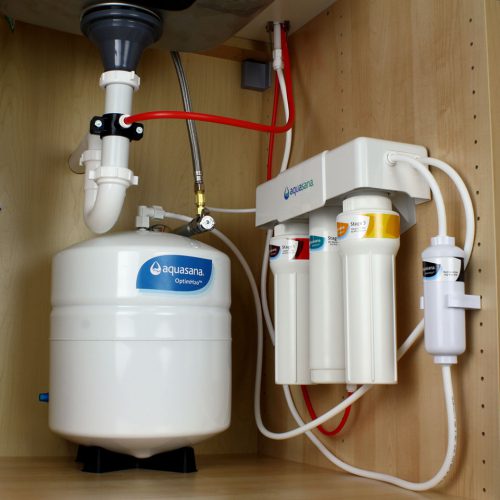There are several reverse osmosis systems and their wiring schemes are slightly different. In this article you will learn about RO-05 Reverse Osmosis water filter installation with manual membrane washing and how it works. First, tap water through a reducer, tee and supply valve gets on a mechanical five-micron cartridge, which is designed to remove dirt, rust and other sediments. Then water passes through the coal cartridge, which removes up to 98% chlorine, or rather chlorine-containing compounds, and other chemical and organic substances.
The next stage of treatment is another cartridge – mechanical or coal. In this case, the choice of cartridge depends on the chlorine concentration in untreated water. To make the right choice, we recommend that you check the chlorine content of the water. To do this, take a look at the used cartridges, if they are covered with slime (bacterial colonies), which means that there is no chlorine in the water. In this case, a mechanical propylene fibre cartridge will work for you and provide more reliable and long filtering. First of all, such cartridges are necessary for those who receive water from the well.

The water then enters the main reverse osmosis filter, a semipermeable membrane that is responsible for removing 95-99% of the soluble substances that pollute your water. The membrane divides the incoming water into two streams – permeate and concentrate (clean and dirty water, respectively). The clean water then passes through a four-way valve and enters the storage tank. The dirty water flows into the sewer system via a drain clamp.
Clean water from the storage tank flows out quickly under pressure when the tap is opened at the sink, while it passes through the reverse osmosis post-filter: mineralizer, carbon cartridge or bioceramic. It is here that a pleasant taste of water is formed and, if necessary, minerals are added to it. Also some post filters are able to correct the acidity level of the purified water. Reverse osmosis post filters can be installed on either a single or double tap.
We recommend using AP-MIN mineralizer and AP-GAC post-filter. The first one corrects the pH level and saturates the water with the necessary minerals, while the second one effectively removes gases that the semipermeable membrane has missed. However, if your water is too polluted with bacteria, we do not recommend you to put in a post-filter, as bacteria quickly multiply on it as slime and after a couple of weeks the cartridges stop filtering and saturating the water. In this case, we recommend regular disinfection of reverse osmosis lice.

Replacing cartridges in the reverse osmosis system
For clarity, we provide brief instructions on how to replace the cartridges yourself:
- Disconnect the water supply to the filter by turning the ball valve on the water distribution tee.
- Drain the hydraulic accumulator (treated water storage tank) or turn the locking mechanism on it.
- When you open the tap, relieve the residual pressure.
- Place the dishes or rags on them and unscrew the flasks.
- Remove old cartridges and rinse flasks thoroughly with running water without using chemicals.
- Wipe off the available parts of the water filter head.
- Insert new cartridges. Make sure that the rubber gasket on the carbon cartridge does not shift.
- Lubricate the rubber gasket located on the outer surface of the bulb with silicone.
- Screw in the flask with the key all the way to the stop.
- Resume the water supply to the filter. To do so, open the ball valve on the water distribution tee and the gyro accumulator lock mechanism.
